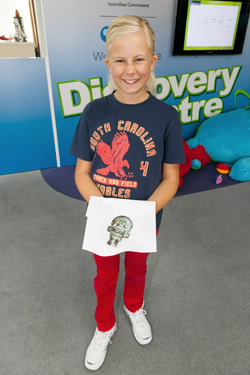 |
| Victoria with an ancient artefact found on her family's property |
When Kate’s 11-year old daughter found an intriguing artefact on their property this summer she was determined to get to the bottom of it.
Victoria was playing near an excavation pit on their Hunter Valley property, when she spotted an unusual object buried about a metre below the surface.
Her first thought was that it was a bit of metal, until she looked more closely. She took it to show her parents and they started the process of trying to identify it.
“At first we thought it was a broken ceremonial knife but it turned out to resemble an idol figurine,” said Kate.
She spent many hours online to come to the conclusion that it might be a depiction of Naylamp, supposed mythical ruler and founder of the Moshe group, who predated the Incans. These Andean peoples lived from the 1st to the 8th century.
“We saw a big statue of him in front of the museum in Peru online,” said Victoria, who is a Year 6 student at Rosary Park Primary School.
An inquiry to a major archaeological museum in Peru did not provide any fruitful leads.
The next step was to try and have it dated to see if it could be authentic. A quick online search brought up the nuclear services provided by the Australian Nuclear Science and Technology Organisation.
Kate and her husband David contacted senior research scientist Mihail Ionescu about possible dating to establish its authenticity.
The first step he recommended was to use an ion beam analyser which is used to determine the chemical elements in a metal sample.
“We wanted to know if it was bronze or something more recent,” said Kate.
The family went back with a metal detector to see if there were other artefacts but found nothing.
The previous owner of their property had been a local vet, which did not explain any possible connection to the artefact.
Mihail Ionesco used two nuclear techniques, particle induced X-ray emissions (PIXE) and particle induced gamma ray emissions (PIGE) to determine the elements in the figurine. The techniques were carried out on the 2MV STAR tandem accelerator.
The measurements were based on the green patina, black patina, and a lightly polished surface to expose the bronze yellow colour. He also photographed the object using an optic microscope to identify traces of post-casting mechanical processing.
The results indicated that the object is a simple alloy (brass not bronze) containing copper and zinc as major elements with smaller quantities of iron, lead and tin.
He was unable to determine if the thickness of the patina was due to a natural or artificial process. A fake patina usually contains chlorine or sulphur and this object did not. Holes found in the neck of the object appear to be the result of the casting technique.
Although the authenticity is not clear, it is looking like the artefact may indeed be very old but the definitive answer is not in. Ionescu has shared the analysis with the family.
The next step would be to compare the surface analysis with those of similar artefacts that have been authenticated by other methods. Because of the lead in the sample, it may also be possible to do some isotopic dating on it.
“It’s a great example of how we use science in practical applications such archaeology. Because the girl’s parent work in a nuclear field, they knew the power of these techniques,” Ionescu said.
ANSTO’s Discovery Centre Leader, Rod Dowler, who has been assisting with the inquiry, summed it up, “If the object is finally authenticated, how do you explain how it got there? “Another question to answer about a very puzzling object.
Published: 23/03/2015


